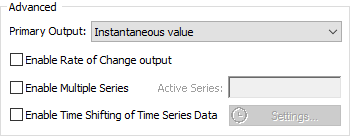GoldSim provides five advanced options for defining and using Time Series elements:
- You can enter historic time series data and then instruct GoldSim to adjust the time/date column (time shift) in a specified way for each simulation (e.g., in order to start at a random point in the data series, or to shift the series forward so that historic dates are appropriately mapped onto the simulated dates).
- You can specify multiple sets of time series data within a single Time Series element A type of input element that provide a very flexible and powerful way to input external time histories of data., and then specify which series is to be used for any particular simulation. For example, this allows different time series data to be used for each separate realization A single model run within a Monte Carlo simulation. It represents one possible path the system could follow through time. in a Monte Carlo simulation A method for propagating (translating) uncertainties in model inputs into uncertainties in model results..
- You can read the output of any other element in GoldSim, and "record" the results, and then "play them back" in a subsequent run of the model. Among other applications, this can be used to copy results from one model and use them as inputs for another.
- You can link to a "time series definition" that was output by another Time Series element within an embedded SubModel A specialized element that allows you embed one complete GoldSim model within another GoldSim model. This facilitates, among other things, probabilistic optimization, explicit separation of uncertainty from variability, and manipulation of Monte Carlo statistics. or from an external function (a DLL). The primary application of this advanced option is to transfer time history data between SubModels.
These features are discussed in detail in the
Many of these advanced features are accessed by pressing the More button on the Time Series dialog, which provides access to the “Advanced” section of the dialog:

Learn more
Related topics…
- Advanced Time Series Options
- Browser View of a Time Series Element
- Defining the Data Type and Units for a Time Series
- Generating Discrete Changes Using Time Series Elements
- Referencing a Time Series Using a Function
- Specifying the Source of the Input Data for a Time Series
- Specifying Time Series Outputs
- Specifying What the Input to a Time Series Represents
- Time Series Examples
- Viewing and Editing Time Series Inputs